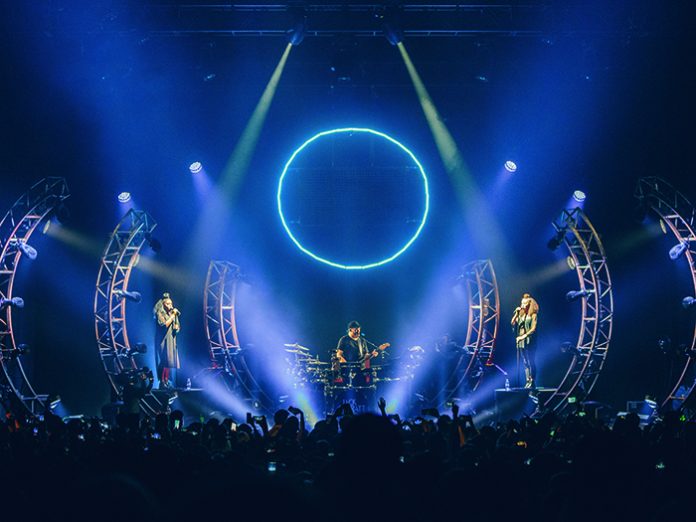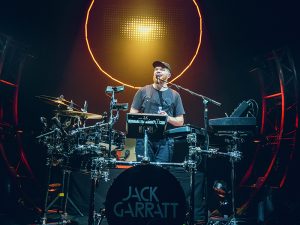Multi-instrumentalist, producer and recipient of the 2016 BRITs Critics’ Choice Award, Jack Garratt, has certainly had quite a year. To cap off 12 months of relentless ascendency, he and his tight-knit crew set out on a UK headline tour to showcase exactly why he’s received such critical acclaim. TPi’s Ste Durham reports.
The one-man band certainly has come a long way since the days of back-mounted bass drums and hands-free harmonicas. Now fans can be treated to an album-quality performance of songs that would have, even until relatively recently, been near impossible to reproduce live. On his latest UK tour, Jack Garratt has delivered that feat and then some by combining an ingenious set-up with prodigious talent and a truly irreplaceable touring crew.
While looping technology is far from revolutionary, and even its use in mainstream pop is now not uncommon thanks to a certain Mr Sheeran, the rig that Jack Garratt and his team have developed during this album cycle is a different animal altogether. Rather than looping a single instrument multiple times, Garratt has synthesisers, acoustic drums, guitar and stacks of other samples at his disposal – as well as a pretty enviable vocal range.
WE HAVE THE TECHNOLOGY
One of the men at the heart of this fascinating setup is Abelton / MIDI Tech, Luke Oldham, who helped to overhaul Garratt’s rig prior to his 2016 festival run, and currently holds office as Lord Mayor of Ableton City. Although his (official) job title suggests he might be primarily concerned with babysitting timecode-related starts and stops during the show, his actual duties extend closer towards the those of a full-time band member.
He explained: “Not taking into account FOH and monitors, I’d say the show is pretty reliant on that Ableton project that I have at the side of stage. It’s not like Jack is just launching a song and it plays eight tracks of identical length – he uses no click whatsoever so it’s completely organic. There’s a lot more for me to think about than on your average playback gig but that makes it much more fun.”
While, on the surface, Oldham has a similar A/B system setup to many of his contemporaries in order to ensure full redundancy, many of the components have had to be adapted to accommodate Garratt’s distinctive performance style.
In short, where a more traditional rig with a DirectOut Technologies EXBOX.BLDS like the one at the side of stage in Manchester has its redundancy based on a BLDS (Buffer Loop Detection Signal) tone, this was proving a touch too sensitive for the job.
Oldham explained: “Usually the EXBOX is looking for things like the buffer dropping, even for one sample during a set – essentially it’s looking for the computer struggling rather than waiting for it to drop out. We have so much going on from an input and processing point of view that it was switching unnecessarily, which was causing confusion at FOH as well as the side of stage.
“We had a conversation with the guys at DirectOut, who’ve been unbelievably helpful, and they wrote us a new piece of firmware allowing us to use the EXBOX more like a traditional switcher, with a regular tone and a specified time frame before switching in the event of loss of that tone. It’s worked so well already. It’s really not the firmware’s fault, it’s just that we use the system in a very different way than most people have before us.”
Another way of ensuring potential failings are dealt with quickly and calmly is the constant communication between Garratt, Oldham, Monitor Engineer Steve Donovan and Backline Tech, Jamie ‘Slippers’ Biles.
Oldham explained: “We’re all over the comms during a show. There are so many things he’s controlling on stage that there’s no point in having a computer screen up there as well. His eyes are all over the place as it is. It’s important that we make sure that the loops are actually recording when he hits the pad. If not I’ll tell Steve on monitors, who will bring up the fader to tell Jack, and this minimises any stress – he can just calmly re-loop it and I can give him the thumbs up when it’s good to go. This kind of situation is very rare but, again, it’s another form of redundancy.”
After a busy festival season, and in preparation for Garratt’s autumn touring schedule, the crew decided that an entire overhaul of his stage and Ableton setup was required. After working together on Charli XCX, Nicholson brought Will Sanderson on board early in the summer and tasked him with making the rig as clean, reliable and user-friendly as possible, which required the whole system to be torn down and rebuilt from the ground up in a more holistic fashion.
One such change was taking some of the work off Garratt’s hands; namely the changing of Moog synthesiser presets for tempo-reliant delays or patches. Garratt initially changed these himself, sometimes mid-song, but the new rig let Ableton take care of that job, switching patches based on triggers Garratt was already playing as part of the musical arrangement. Oldham explained: “We introduced something on his pedal board called a Molten Voltage SIMI box, which is one of the most simple pieces of gear on the show but incredibly effective. It’s basically an analogue display that show the name of each song, which indicated to Jack that each programme change out of Ableton has occurred. It just makes him feel that little bit more comfortable on stage.
The crew also wanted to streamline the input list, where previously similar sounds could be produced from several sources – the Roland SPD-SX, or a number of different outputs from Abelton, they wanted all the kick drums to appear on a single kick drum channel, for instance, making their lives (and the lives of future festival broadcast engineers) that much easier.
Nicholson added: “We got into a rehearsal room at Music Bank for four days and Will (Sanderson) dismantled and reprogrammed everything. Now the kick drum comes out of the kick drum channel whether it’s from the kick trigger, an SPD-SX pad or a loop. The levels are consistent regardless of the source, this made it much easier for everyone, including Jack.”
Although it was the crew that brought these improvements into reality, the ethos behind them is concordant with Garratt’s drive to improve himself as a musician, constantly attempting to push both himself and the rig to make the performance as real as possible.
“It’s as organic as it can be, which works so well as it gives you that push and pull. Obviously there are certain triggers where he can bring in BVs, drums, keys and bass for choruses so he can play guitar and sing over the top, as he can’t physically play all these instruments at the same time, though I think he’d give it a good go if he had the chance!
“One of the hardest parts was keeping it the same. So much of Jack’s performance is muscle memory and if there’s even the slightest change then he would have to relearn the whole song, because it becomes second nature. It was really important that his physical interface behaved in the same way as the previous setup.”
While Oldham reasserted that the crew are aware they aren’t, in principle, doing anything new, he was keen to express his amazement at the command Garratt has gained over the rig in such a short time. He said: “When I’m stood at the side of stage watching him play all the different parts and can see all the loops and parts flying through Ableton it’s mind boggling. It’s enough that he can play all these things at all, let alone simultaneously, yet our CPU usage is generally only peaking at around 10-15%. The fact that he does so much of it makes the show so enjoyable and still fascinates me, even after all this time. The novelty just doesn’t wear off.”

MUSCLE MEMORY
The more tangible parts of Garratt’s rig are mounted on a wraparound Gibraltar drum rack, and are maintained and assembled daily by Backline Tech, Slippers. The rack houses a keyboard setup to Garratt’s left (consisting of an M-Audio Keystation 88, a Moog Voyager and two Akai LPD8 pads that control the various looping and audio effects), a Roland SPD-SX sampling pad in the centre and a full acoustic Gretsch drumkit on his right, complete with Zildjan K cymbals. Garratt is endorsed by Fender, and uses Stratocasters exclusively, while his Orange Rockerverb MKIII combo amplifier is housed on a ‘shelf’ that is built into the back of his riser.
Even as an experienced session musician and self-confessed gear nerd, Slippers quickly learned that he was thrown in at the deep end for his first full-time backline gig. He said: “It’s certainly a tricky one that’s for sure! I’ve always teched for myself anyway, so that wasn’t a problem and Ableton doesn’t freak me out as it is probably the most stable part of the rig. Luke knows backline too, particularly the synths, so he’ll give a hand with anything that’s going into Ableton.”
While this is unarguably a daunting gig from a backline point of view, Slippers is also tasked with serving as Garratt’s second pair of eyes during the live show. Constantly throughout the set at Manchester, Slippers was darting around behind Garratt, replacing dropped or misplaced drum sticks, helping to switch guitars over and constantly communicating to ensure the artist’s concentration wasn’t affected by any backline-related issues.
He explained: “Jack certainly is a perfectionist but so am I, so it works really well. His performance is based so much on muscle memory that when he reaches over to play a bassline on the Moog, he doesn’t have to look. He just knows that middle C is there and if it’s not, you can bet he will play the B!
“Because it’s so crucial, it’s gotten to the point where I instinctively know where stuff should be just by looking. All of the rack is marked and memory-locked off but things can still move in transit.” Slippers laughed: “It’s weird – I’ve set the rig up so many times now that if the snare is too far to the left I will feel itchy!”
Garratt, much like Slippers himself, is first and foremost a guitarist, despite spending the majority of his show’s looping synth lines and mercilessly beating the Gretsch acoustic kit. As a result, the guitars and amp are easy to maintain, as are the synths. Unfortunately, the same cannot be said for the SPD-SX. Slippers explained: “It’s my bugbear for sure. They’re great and the routing options are endless but we use it really differently to how it was designed. There are four audio outs on the back, none of which we use.
“We use it as a dumb MIDI controller – all of the pads are MIDI-mapped and all the songs have their programme changes. He beats these things really, really hard and there’s a lot of wear. We tour six SPDs and it’s not uncommon that I’ll have to take one off and spend the morning fixing a broken one. Don’t get me wrong – the SPD-SX is a great product – it’s just that Roland didn’t have Jack Garratt in mind when they designed it!”
Production Manager Jimmy Nicholson was also able to vouch for this, having been able to see the quite frankly ludicrous statistics behind one of Garratt’s typical sets. He added: “When we recorded a show for the lighting guys to do their pre-visualisation, we also recorded every MIDI note from SPD-SX, as they program a certain number of cues to respond to the MIDI from stage. A Protools MIDI note count revealed that in one show he hits the SPD-SX about 4,500 times. Now, there are nine pads and he probably plays one and two much more than the others, but I imagine the rated the life cycle of them is only around 20,000 hits apiece. You can understand now why they don’t tend to last long with Jack using them!”
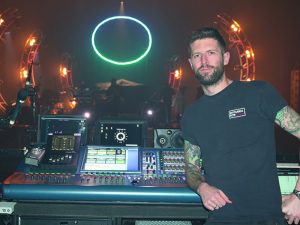
Another of Slippers’ jobs is what he referred to as ‘idiot-proofing’ as much of the kit as possible, which includes taping every connector in place and tightening every screw before the show.
He explained: “My job is to put as many safety nets under him as possible without ripping the authenticity out of what he is doing. The way we’ve automated patch changes on the Moog is a good example of this – we’re just taking weight off him as much as possible. I think it’s fortunate that I’m a musician as well as a tech and can understand what he needs to play each song. He’ll quite often discuss musical things with me as well, which is just as interesting for me. Normally you could have these conversations with the session musicians or your band mates but he doesn’t have any so he can have them with us.”
As well as the new rig being introduced in March, a new crew was also assembled in order to cope with the increasing production value, which was then followed by management changes and another new influx of crew. In fact, it is only since October 2016 that Garratt has had a core crew in support of his lofty standards.
Slippers commented: “Having a stable crew around Jack is massively important because it’s only him out there. When something goes down, if he knows he can step on the shout and have a talk to four mates who he trusts then it will calm him down before the next song.
“Any negativity can affect his muscle memory because he is so in the zone for a gig – he has said to me there are some gigs he doesn’t even remember. He is constantly saying ‘we could automate that but I’m going to do it myself because I know I can do it and it will make me a better musician’.”
BUSY LITTLE RISER
Contrary to what some of his fellow monitor engineers have alleged, the fact that Donovan only has one person to look after on stage doesn’t necessarily mean he has an easy time stood at the side of it. He said: “In a way it’s simpler because you are only dealing with one attitude but I’ve still got a very specific job compared to your usual monitor gig. The difference is that I aim to mix it from a FOH perspective. He is looking for a specific, honed mix instead of a rougher, ‘monitor engineer’ mix. A drummer will want more drums and a guitarist will want more guitar but he plays everything!
“All eyes and concentration on him and even now it’s running smoothly it feels like anything could happen at any moment. If you are not looking at that one person then you’re looking at no one.”
Donovan was another that was quick to stress the importance of interdepartmental communication. He said: “We obviously deal with FOH as and when but Luke and I are constantly chatting, as is Slippers on the other side of stage. We always want to make sure each other is ok and nothing no one is struggling.”
Although the previous rig was reliant on the MADI routing capabilities of a DiGiCo SD11, the refocusing of signals through Ableton has allowed Donovan to select a Midas desk for monitor duties. “I love the DiGiCo but I felt the Midas was a more appropriate work surface to deal with,” he said. “The footprint has grown slightly but it’s helped me to create a handy selection of pop groups (kit group, guitar group, Ableton group and so on) that I can manage with my left hand and still ride the VCA section with my right.”
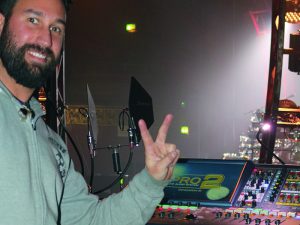
Garratt has 2 L-Acoustics SB15’s underneath the aforementioned amplifier shelf in order to achieve the fabled ‘trouser wobble’ from his rumbling bass lines, while his monitor feed is conveyed via a Sennheiser system to one of his three sets of Ultimate Ears UE18 in-ear monitors. Donovan laughed: “We have three because he has a smashed them in the past by turning his head into the mic while he’s moving between instruments! It will happen from time to time because it’s a busy little riser!”
When Garratt’s IEM are in one piece, he prefers his mix to sound as analogous with the studio version as possible, though Donovan will ride levels a little higher during moments like guitar or drum solos. He said: “Jack will know if there’s something a little bit off and he’ll be able to tell you. He’s certainly got one of the better ears of the people I’ve worked for.“
As well as dealing with production management, Nicholson is also on the crew as Garratt’s FOH Engineer – having been brought into the fold to fill both roles simultaneously. He explained: “It might be difficult if you had to turn up every day and dial everything in on a new console, but it’s a heavily programmed show – the only live mic’d gear is the kit, voice, and guitar. I did the legwork in rehearsals and with virtual soundcheck, so I’m mostly just riding a few key things.”
Nicholson chose a Midas PRO2 – Midas Digital being his go-to consoles since first using the XL8 in 2007: “I went to do the training then and haven’t found anything since that sounds like it. I am so used to it now I can operate in my sleep,” he laughed.
Although he maintained that the gig could still go ahead with minimal outboard effects, he still carried a few essentials for the UK run. This included an Empirical Labs Distressor EL8-X to add vocal compression, SPL Transient Designer, a TC electronic System 6000, and a Waves MaxxBCL unit. He explained: “Obviously you can get software plugins for most of these things but it’s nice to be able to reach over and adjust physical things in the middle of a gig.
“The MaxxBCL, for example, creates harmonics of the low frequencies from the Moog and sub-bass lines and merges them back into the mix – this just gives a bit more definition on the really low, sub-bass stuff. It’s extravagant to have but I had the space in the rack!”
In addition to the Midas, Nicholson also had a couple of laptops at FOH running Smaart and Waves Tracks Live with Dante Virtual Soundcard for multitracking of the show and virtual sound check. Where an in-house PA was being used, a tablet controlled Lake LM44 system processor allowed him to set up the system and EQ from the palm of his hand – a vital step in translating the mix from rehearsals into a new room and PA system every night.
At Manchester Apollo, Adlib Audio was the local supplier and delivered and installed an L-Acoustics K2 system complete with KS28 subs, which was the PM’s first rider choice. Tour audio supplier Britannia Row Productions supplied a similar system for the latter part of the tour in empty rooms around the south of England.
The majority of Garratt’s microphones were Sennheiser, with AKG C414’s on the drum kit and a Neumann KMS104 on the vocal. Nicholson said: “The Neumann 104 is great off-axis and that helps with his constant movements. We toyed with the idea of adding another mic position but it wouldn’t really help things as he’s never in one place for very long. We have joked with him about wearing a Britney-style headset mic, but that is never going to happen!”
CUE HEAVY
With the lighting fixtures having to make up for a great deal of the on-stage movement that is impossible for Garratt while he is glued behind his one-man-band equipment rack, the design was of paramount importance. Creative outfit Okulus was brought into the fold during the revamp period to update the rig and make sure there was enough visual action going on to stack up against the impressive musical performance.
Okulus co-founders James Scott and Louis Oliver began the initial design for Garratt’s show in February 2016: “The idea was centred around the curved trusses that were laced with lights,” said Oliver. “The whole look and feel of it was meant to be quite rustic and that was the case from the floor to the air.”
Scott added: “The main focus is obviously Jack so we ran with the idea of creating a focal point through the structures, which hints at him being the epicentre of the show. Jack really wanted a curved riser as well, which we lined with Robe Robin LEDBeam 100’s.”

When it came to sourcing the gear, duties were split between Siyan and Adlib on a venue-specific basis. Oliver said: “Choosing Siyan to supply the lighting was a no-brainer, and it means we have Mark Thornton and Jason Tomes on the crew. They supplied the flown rig for the end of the run in empty rooms, while Adlib took care of local supply for the show mid-tour in Manchester. Siyan also supplied the floor package throughout, though Jack owns the towers, which were constructed by Brilliant Stages.”
As Garratt had requested some extra branding for this particular run, Scott and Oliver decided to add two more unconventional aspects to the show design – a central grid of 28 Chromlech Elidy-S tungsten panels, also treated with the same scenic paint as the trusses in a custom frame, and a ring formed from 29 Martin VDO Sceptron bars to mirror the Garratt’s album artwork.
Oliver explained how the Elidy panels worked: “We can run lo-fi visuals through it, or select individual pixels and create shapes. We have full control of this through the grandMA2 and could create some effects that suited the overall set design really well.”
As well as the Elidy, the duo was also quick to point out that the 11 Showline Nitro 510Cs were irreplaceable in their design for Garratt. Scott commented: “From our original spec, we knew there were certain things we couldn’t do without, but the rest of it still fell into place pretty quickly. We knew we were going for GLP impression X4’s so we could use the macros, and the Robe 600 LEDWashes are great as a key light – I wouldn’t change those either.”
Although the rig had to create movement and draw focus towards Garratt, the pair also made his talent the priority above all else. Scott said: “Jack’s performance alone is entertaining and we wanted to amplify that instead of distracting from it; this is why everything is focussed on him. Most of the positions are down or around him, though there are some big audience looks during the show as well.
“The set is very cue intensive so we programmed as much as we could using WYSIWYG. Apart from the kind of tweaks that are unavoidable on the road, particularly with a show like Jack’s, not much has changed from WYSIWYG to real thing.“
Given the fact that Oliver and Scott have chosen to move away from the world of live touring, and original lighting operator Ryan Nixon was unable to take part in the UK tour, the production turned to Nikita Jakovlev to man the MA Lighting grandMA2 for Garratt’s live shows.
He commented: “My relationship with Okulus was a key factor in getting involved with the tour. They needed a grandMA2 operator for the UK run and as I had worked with Jack on a few bits during the summer festival season then it worked out quite well.
“The design and most of the programming had already been done for the festivals and some previous shows so I could just jump straight in. In my opinion, the current design with the curved towers, Elidy and Sceptron circle works really well. The height difference in the towers really creates a sense of depth so most of the stages end up looking bigger than they actually are. The Elidy gives plenty of eye-candy and the Sceptron circle is a nice reference to the Phase album cover.”
As was the case during the design process, Garratt remained heavily involved with the lighting on a day-to-day basis. Whether this is suggesting starts and stops to songs or the more detailed job of triggering lighting cues via MIDI from his SPD-SX, the artist is always keen to make sure the audience experience the perfect Jack Garratt performance.
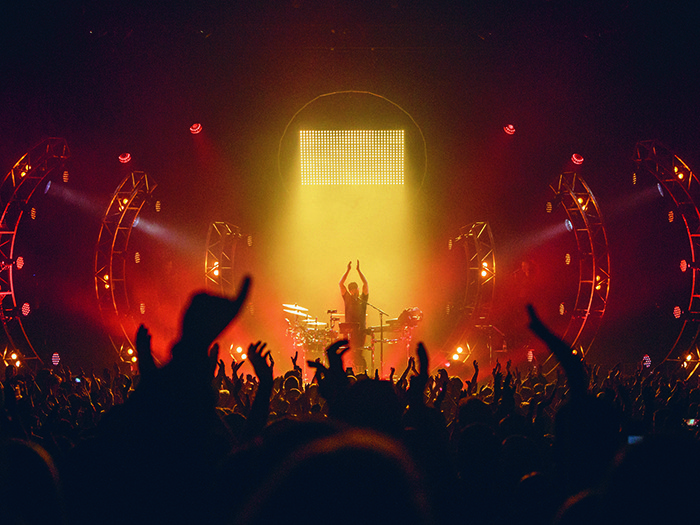
Jakovlev said: “All of the show is manually operated so you constantly have to know where you are in the song and pay attention to what Jack is doing. A few blackouts are cued by Jack clicking his fingers so starts and stops do end up being very particular.
“The longer sound checks were very useful at the beginning of the tour to make sure everything was behaving as it should and we could make sure that all of the important cues were correct.”
He continued: “On a day-to-day basis, there is a list of songs that he can potentially do, and every one of those songs is already programmed with its own page. It’s really a matter of putting the songs in the right order so there are no issues during the show and tweaking anything that we might not have played in front of a live audience yet.”
To accentuate the visual side of Garratt’s performance for the London and Brighton dates, BPM SFX was brought on board to provide some additional firepower for the crew to make use of.
Senior Project Coordinator for BPM, Katie Strickland, explained: “We used four G Flames with circular flame bars which were placed just in front of his set and were used throughout the track Fire. In addition to this we used 12 Powershots across the front truss for an instant hit of white and blue confetti at the end of the finale, Worry.
“Before the hit of confetti there was a full stage blackout, and as the lights returned, so did an explosion of confetti. The G Flames were controlled using Galaxis Wireless Firing System, and the Powershots were controlled by our firing pack.”
She continued: “Jack is an incredible artist, and someone who we have wanted to work with for a while so we were really excited when this call came through. The whole team were an absolute pleasure to work with, and we look forward to integrating more special effects into his shows in the future.”
SURPRISE YOURSELF
PM Nicholson was happy to go with the flow when it came to choosing suppliers. He commented: “Brit Row has been involved with Jack since the get-go, as has Rock-It Cargo for freighting duties and, of course, Siyan. Phoenix Bussing and Fly By Nite were great as always, and only new thing was getting All Access in for the risers.”
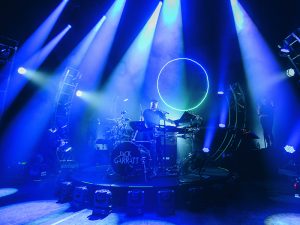
In Garratt’s previous tours, the crew had been using whatever was locally available for the artist’s central riser, but this proved problematic when the reality of the live shows set in. Nicholson continued: “We used some really wobbly risers and that has a very serious impact on Jack psychologically when he performs. Just like the SPD-SX, he uses a riser very differently from most.
“Usually people will stand to play keys or guitar on a riser or sit down behind a drum kit, but he moves around so much, as well as dancing as he plays. It’s more akin to a riser full of dancers, as well as all of the backline, some of which is only held together with micro USB connectors!”
While the crew originally toyed with the idea of a grated riser, this also proved to be not feasible when the visual effects possibilities were stacked up against the detrimental effects it could have on Garratt’s balance and concentration. All Access Staging & Productions provided the artist’s circular riser, which was 12ft in diameter, as well as the rear ‘shelf’ that housed his guitar amplifier and stage subs. For the London and Brighton shows, All Access also provided a pair of circular risers, both 4ft in diameter, for the backing vocalists that were added for those dates.
Nicholson added: “Jack generally doesn’t like change and it’s a delicate process to convince him of the benefit of altering things – whether that’s adding a carpet to the riser or rebuilding his Ableton session. I’d say Slippers is pretty essential to this process as they have a great relationship.”
While this was evidenty true upon watching both the show and the rehearsal in Manchester, it still seems remarkable that such a solid bond can be made in a relatively short period of time – particularly in such a high-pressure environment. This can be said for the rest of Garratt’s crew as well, and the electricity of such a high-risk production was thoroughly palpable throughout the day. With the tour now over and new wheels in motion, it’s certainly intriguing to see what this highly professional and exciting crew will conjure up next…
TPi
Photos: Giles Smith


